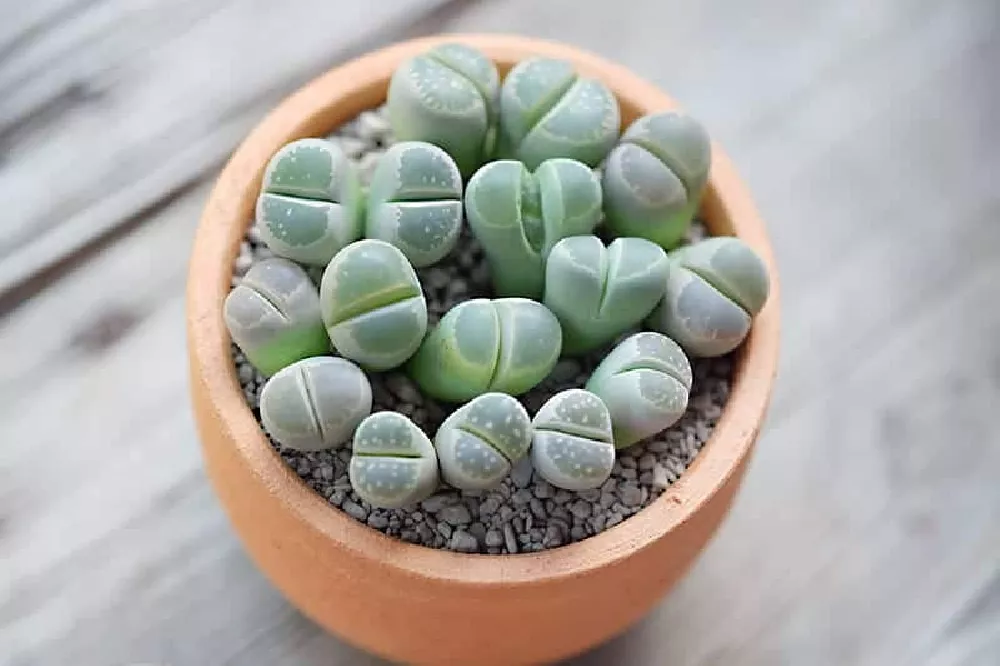- Home >
- Houseplants >
- Lithops
There are many varieties of Lithops plants, all of which are desert plants from regions in southern Africa. These plants are small types of succulents that live well in the hot sun and dry soil. Due to those characteristics, it is relatively easy to raise a Lithops plant indoors, with minimal upkeep. Lithops plants are generally small, round, and resemble a pebble. Because of that size and their impressive flowers, these plants often go by the name “flowering stone” or “living stone.”
- Unique growth habit makes for a stone-like appearance.
- Very minimal watering needs.
- Able to survive in compacted soils.
Planting and Care
Planting instructions
Since Lithops plants come from one specific region of the world, most people will need to grow them as indoor plants. Before you can do so, you need to find an area that receives plenty of sunlight. Aim to give your Lithops plant about five or more hours of daily sun exposure.
After finding plenty of sunlight, you’ll want to grow your Lithops plant in soil that is exceptionally dry and drains well. This lack of moisture mimics the natural conditions in which this plant thrives. Try using cactus soil or mix sand with standard potting soil.
Watering and nutrients
Watering for Lithops plants should be minimal. These plants thrive in the desert, so you’ll only need to give them water if the soil becomes completely dry. When you water these plants, only do so until the top inch of soil is saturated. Too much water can be a detriment to these plants.
Lithops plants will also grow well without the aid of fertilizer. If you do decide to fertilize your Lithops plant, you should do so sparingly. A light yearly application will be enough. Make sure you use a fertilizer that has a high potassium content as well.
Pollination
Lithops plants are not self-pollinating species. Instead, they rely on pollinator species, such as birds and insects, to take care of pollination for them.
When one of these plants is in bloom, it will display a single flower. That flower opens during the day to invite pollinators to visit. Once the sun begins to set, the flower will close, simultaneously ending the possibility for pollination until the next day.
Pests, diseases, and animals
Pests and diseases are not often a problem for a Lithops plant. However, there are some instances in which these plants can experience an infestation. In those cases, it is most likely spider mites, aphids, or mealybugs.
Mice may also disturb your Lithops plants as those rodents see the plant as a viable food source. Beyond those issues, the only other problem that you should be wary of is the rot that happens after a Lithops plant receives too much water.
Achieving maximum results
Taking care of a Lithops plant is relatively easy. In nearly all cases, you will need sunlight and well-draining soil. However, there are more than 140 distinct varieties of Lithops plants. For that reason, you must know about the specific variety of Lithops you have. That will not only allow you to take better care of your plant, but it will also allow you to anticipate the colors it will display. As you search through these many varieties, you’ll find many unique hues and patterns.
FAQs
What is the best watering frequency for Lithops plants?
If you have any understanding of Lithops plants, then you know they need very little water. However, that guidance does not give a clear indication of exactly how little water they truly need. Generally, the most you should water a Lithops plant is about once every two weeks. But even that can be excessive in some cases. The best way to decide when to water this kind of plant is to notice when the soil is dried out entirely.
What happens if you over-water a Lithops plant?
Over-watering is one of the biggest mistakes a Lithops plant gardener can make. However, if you make this mistake, it will be somewhat easy to recognize. When you over-water a Lithops plant, the leaves will begin to turn yellow. They will also take on a soft texture compared to their normal firmness. In extreme cases, an overwatered Lithops plant will develop rot and eventually die. That is why it is so important to make sure you don’t give too much water to your Lithops plant.
How many types of Lithops plants are there?
There are many different types of Lithops plants that you can grow in your garden. The word Lithops refers to the genus, and within that genus, there are around 35 individual species and more than 140 varieties. Each type of Lithops plant will have its foliage pattern and flower color. Since there are so many different varieties available, you are sure to find one with an appearance you love.











